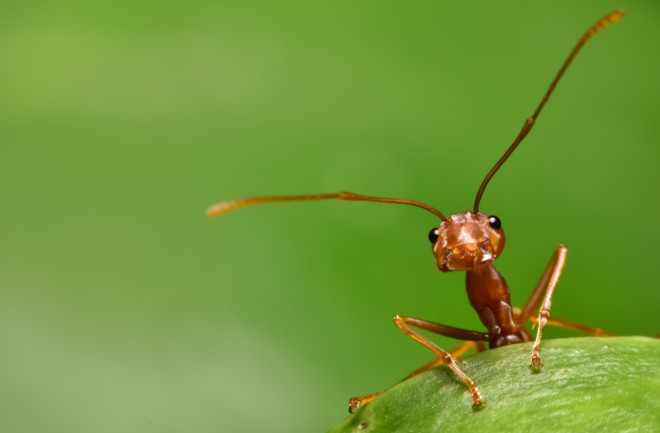A growing body of research is making some surprising discoveries about insects. Honeybees have emotional ups and downs. Bumblebees play with toys. Cockroaches have personalities, recognize their relatives and team up to make decisions. Fruit flies experience something very like what we might call fear.
Read More: Bumble Bees Like To Play Just For Fun
Insects having emotions is not a new idea. In 1872, in The Expression of the Emotions in Man and Animals, Charles Darwin wrote, "Even insects express anger, terror, jealousy and love . . . " If insects have fun with toys or flee in fear when you brandish the fly swatter — if those expressions of anger, terror, jealousy and love reflect something on the inside — then it's clear that insects have emotions, sentience, consciousness. Drop that flyswatter right now!
But we don't know what's inside, at least not yet. However, neuroscientists and philosophers are beginning to take the idea of insect consciousness seriously.
Do Insects Have Feelings?
In an article published last year in Science, Frans de Waal and Kristin Andrews point out that science generally distinguishes between feelings and emotions. Emotions, they write, "are measurable physiological and/or neural states that are often reflected in behavior." (That frantic buzzing when you mess with a bee.) Feelings, on the other hand, are "private conscious states that are not publicly observable and hence are inaccessible to science."
We're pretty sure other humans have feelings because they can tell us they do. Nonhuman animals can't. Was the bee buzzing in rage? Fear? Or was it just a physiological reaction to a threat? We can't know because the bee can't tell us.
Read More: The Complex Ways Humans Empathize With Other Animals
However, animals aren't the only creatures who can't tell us what's happening inside. Human infants are silent on the matter as well. As de Waal and Andrews point out, it was only in the 1980s that doctors came to believe human babies felt pain. Prior to that, surgery on infants was routinely done with no anesthesia.
In recent years, humans have gradually offered membership in the sentience club not only to their own young but to some other animals as well. In the last decade, many countries have begun to ban experimentation on all great apes. The U.S. ended research on chimpanzees in 2015. The membership application for fish is under consideration. The U.K. government recently recognized lobsters, crabs and octopuses as sentient. But the question is still very much open when it comes to insects.
Evolutionary Connection
Andrew Barron is a neuroethologist at Macquarie University in Sydney, Australia. Barron and colleagues are behind much of the foundational work on bee brains. In 2016, he and Colin Klein, a philosopher of cognitive neuroscience at The Australian National University in Canberra, published a paper arguing that insects' brains have the capacity for subjective experience.
Barron and Klein's argument follows on the research of Swedish neuroscientist Björn Merker, whose work suggests that the more basic forms of consciousness are located not in the cortex, which insects do not have, but in subcortical structures of the brain, which insects do have. "These subcortical structures are quite big and have a huge amount of processing power, with incredibly complex connections between them," says Barron.
Barron describes this as "a behavioral control system that operates by creating a rudimentary model of the organism in space." So the beetle mooching around on the stones of your patio has a sense of where it is relative to its environment — what Barron calls an "egocentric view of the world." It knows where beetle stops and paving stone starts. It likely feels the warmth of the sun on its carapace and the softness of the moss under its feet.
Barron is careful to point out (to excited journalists with beetles on their patios) that there's a difference between being aware and being self-aware, between being self-aware and being able to reflect on that awareness. There are many membership levels in the sentience club. But somewhere among all those types of awareness, says Barron, you'll find the awareness of insects. If Merker is right, he says, "we could reasonably extend a level of very, very elemental awareness to an insect." In other words, what it feels like to be a beetle is likely very different from what it feels like to be a human, but odds are good that it feels like something.
Barron and Klein also argue that these structures may be the evolutionary antecedents of our own form of consciousness. "These behavioral control systems go back to the lampreys," says Barron. It doesn't seem right that "all of a sudden the nature of behavioral control changed radically the moment that the cortex came in."
Just the Beginning for Insect Consciousness
Jessica Ware is associate curator of invertebrate zoology at the American Museum of Natural History. Her research focuses on the evolution of behavioral and physiological adaptations in insects. She's unsure what the similarities in these subcortical structures mean for insect consciousness. "We don't really have enough information to distinguish between what could be consciousness or awareness of the surroundings and what, with our lens as humans, could be us interpreting that as consciousness."
Still, she loves the idea of expanding the discussion of consciousness. "We're just at the beginning of this kind of research; the doors are just opening up to really explore in this arena," she says. "This means we might have stopped looking at what it means to be conscious from an anthropocentric view."
Read More: Yes, Animals and Insects Have Stood Trial in Court
